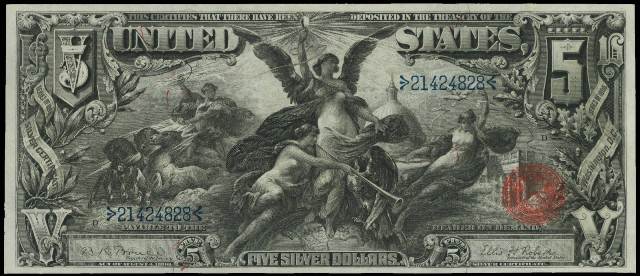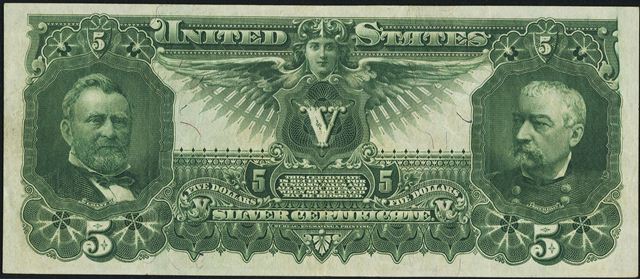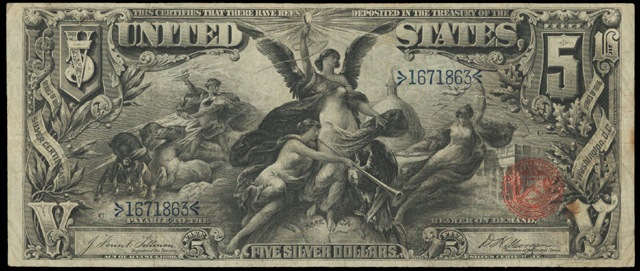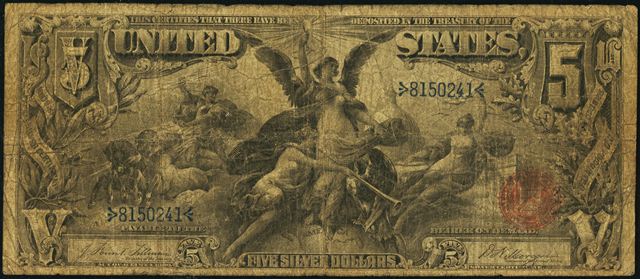Series of 1896 $5 Silver Certificate – Educational Note
History: The United States first started printing large size notes in the 1860s. Up until 1896 most all issues had a fairly similar design structure. The front of each bill had a portrait of a famous American leader and there might have been a vignette or engraving that had something to do with a historical achievement. 1896 silver certificates are very different. They were considered true artwork. The front design shows the US Capitol dome, a chariot with horses, and an angel with wings. This design was a huge change from what people were used to seeing. The designers and engravers were well aware that the 1896 $5 bill was very important. It was thought that people in rural America would get a chance to see some culture because they were viewing art in their money.
Nickname: People in the collectible currency field have one name for an 1896 $5 silver certificate and that is a “five dollar ed.” This was classically called Electricity Presenting Light To The World. If you said that today you might get some weird looks. Grant and Sheridan are both on the back of the 1896 $5 bill. However, those two men are much more closely associated with other pieces of paper money.
Other Facts: The 1896 $5 silver certificate is generally considered to be the most beautiful piece of paper money ever issued by the United States. It is an iconic bank note. There were only three denominations issued for the 1896 educational series. Those were one, two, and five dollar bills. The five dollar bill is definitely the most expensive and rarest. If you are collecting large size currency, you pretty much have to buy an 1896 $5 silver certificate.
Values and Grading: The 1896 $5 silver certificate is the single most valuable piece of large size United States currency that is also still regularly available. There are other much rarer and more expensive bills out there. However, in terms of items you can purchase at will, the 1896 $5 bill is the most expensive. It is important to remember that serial numbers and signature combinations really don’t matter on this series. Yes, a serial number under 100 still commands a premium. However, the notes are already so expensive that the number will rarely affect the value. There are only 3 signature combinations, all of which are equally rare. Star notes were not issued. The rest of our guide helps explain grading and how that affects values.
Choice Uncirculated or Better: As always, choice uncirculated 1896 $5 bills are very expensive. This applies to notes graded 64 and higher. There is a huge price difference between something graded as a 66 and something graded as a 67 or higher. Grading firms are very critical on such high value items. Superb grades are rarely awarded. If you want something in the 64 or higher grade you might get lucky and only spend $8,000. However, more often than not you are looking at something in the low five figure range. Notes in this grade have to literally be absolutely brand new, no folds, no bends, crisp white paper, etc. Even the slightest blemish will knock them down to one of the lower grades below.

We Pay $10,000 Or More For Uncirculated 1896 $5 Bills
Extremely Fine to About Uncirculated: 1896 $5 silver certificates in this grade usually get bought fairly quickly if they are priced intelligently. The note below is graded as XF. At first glance it looks perfect. However, if you look closely you can see three vertical folds spaced at each quarter of the note. A good rule of thumb is that if it looks like a fold, then it is a fold. This is a popular grade for 1896 $5 bills because you can get something with a lot of eye appeal for a fraction of the cost of the same note in uncirculated condition.

We Pay Between $3,000 and $6,000 For Notes In This Condition
Fine to Very Fine: This grade point implies that the note will be circulated. It should still be fairly crisp, somewhat bright, with no obvious condition issues. There are not a lot of 1896 $5 bills that fall into this category. They tend to come either very nice or very poor. The specific note we have pictured graded as a Very Fine 20. At first glance you can’t really see any folds. However, it is obvious to the trained eye that the paper is soft and it is hiding a lot of use. There are even some very light foxing spots. Something like this should sell for around $1,500.

This Is A Nice Mid-Grade 1896 $5 Silver Certificate
Very Good and Lower: We see a lot of 1896 $5 silver certificates in poor condition. Fortunately though, thanks to all of the dark printing on the front of the bill, these don’t always look terrible even when they are terrible. A lot of dirt and wear can be hidden by the overprint. Something in very good condition (which means 10 or worse out of 70) should only cost a few hundred dollars. Expect to have to deal with tears, ink, rust, and other problems. We normally don’t recommend buying low grade items. However, if you are working on a budget, sometimes you just have to settle.

An 1896 $5 Silver Certificate Like This Is Worth A Few Hundred Dollars
Need an Appraisal or Offer? We are very aggressive buyers of 1896 $5 silver certificates. We would love a chance to make an offer on yours. Just send scans or digital photos of the front and back and we will respond back quickly with the value and what we can offer. Sales@AntiqueMoney.com


